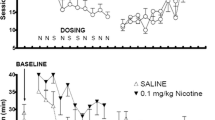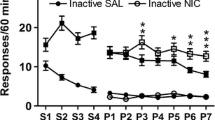Abstract
Rationale
Nicotine may enhance the reinforcing value of other reinforcers. It is unclear whether nicotine enhances responding maintained by all reinforcers or whether there are limits to this role.
Objective
The objective of the study is to test the generality of nicotine-induced increases in reinforced responding by using an observing response procedure, which generated measures of responding maintained by food reinforcers, conditioned reinforcers, and responding during extinction. We also examined whether nicotine increased resistance to extinction and whether nicotine’s effects could be characterized as rate-dependent.
Materials and methods
Rats received presession subcutaneous injections of Vehicle (n = 5), 0.3 (n = 6), or 0.56 (n = 6) mg/kg nicotine for 70 sessions. Resistance to extinction was also assessed by removing food for five sessions.
Results
Nicotine did not consistently affect food or extinction responding. Both doses of nicotine produced increases in responding maintained by conditioned reinforcers, but did not increase resistance to extinction. Predrug response rates accounted for a small but significant percentage of the variance in the drug effect.
Conclusion
Although there was a tendency for nicotine to increase low predrug response rates (i.e., response rates just prior to nicotine administration), 0.3 and 0.56 mg/kg nicotine systematically increased responding maintained by conditioned reinforcers. The results are consistent with a reinforcer-enhancing role of nicotine. However, nicotine did not increase resistance to extinction, nor did it increase food-maintained responses. Nicotine may selectively increase responding maintained by moderately reinforcing stimuli, such as the conditioned reinforcers used in the present study.




Similar content being viewed by others
References
Baum WM (1973) The correlation-based law of effect. J Exp Anal Behav 20:137–153
Bechtholt AJ, Mark GP (2002) Enhancement of cocaine-seeking behavior by repeated nicotine exposure in rats. Psychopharmacology 162:178–185
Branch MN (1984) Rate dependency, behavioral mechanisms, and behavioral pharmacology. J Exp Anal Behav 42:511–522
Case DA, Fantino E (1981) The delay-reduction hypothesis of conditioned reinforcement and punishment: Observing behavior. J Exp Anal Behav 35:93–108
Chaudhri N, Caggiula AR, Donny EC, Booth S, Gharib M, Craven L, Palmatier MI, Liu X, Sved AF (2006a) Operant responding for conditioned and unconditioned reinforcers in rats is differentially enhanced by the primary reinforcing and reinforcement-enhancing effects of nicotine. Psychopharmacology 189:27–36
Chaudhri N, Caggiula AR, Donny EC, Palmatier MI, Liu X, Sved AF (2006b) Complex interactions between nicotine and nonpharmacological stimuli reveal multiple roles for nicotine in reinforcement. Psychopharmacology 184:353–366
Chaudhri N, Caggiula AR, Donny EC, Booth S, Gharib M, Craven L, Palmatier MI, Liu X, Sved AF (2007) Self-administered and noncontingent nicotine enhance reinforced operant responding in rats: Impact of nicotine dose and reinforcement schedule. Psychopharmacology 190:353–362
Clark A, Lindgren S, Brooks SP, Watson WP, Little HJ (2001) Chronic infusion of nicotine can increase operant self-administration of alcohol. Neuropharmacology 41:108–117
Cohen SL, Riley DS, Weigle PA (1993) Tests of behavioral momentum in simple and multiple schedules with rats and pigeons. J Exp Anal Behav 60:255–291
Davison M, Baum WM (2007) Do conditional reinforcers count? J Exp Anal Behav 86:269–283
DeFulio A, Hackenberg TD (2008) Combinations of response-dependent and response-independent schedule-correlated stimulus presentation in an observing procedure. J Exp Anal Behav 89:299–309
Dews PB (1958) Studies on behavior: IV. Stimulant actions of methamphetamine. J Pharmacol Exp Ther 122:137–147
Dinsmoor JA (1983) Observing and conditioned reinforcement. Behav Brain Sci 6:693–704
Dinsmoor JA, Brown MP, Lawrence CE (1972) A test of the negative discriminative stimulus as a reinforcer of observing. J Exp Anal Behav 18:79–85
Dinsmoor JA, Mulvaney DE, Jwaideh AR (1981) Add Conditioned reinforcement as a function of duration of stimulus. J Exp Anal Behav 36:41–49
Donny EC, Chaudhri N, Caggiula AR, Evans-Martin FF, Booth S, Gharib S, Clements LA, Sved AF (2003) Operant responding for a visual reinforcer in rats is enhanced by noncontingent nicotine: Implications for nicotine self-administration and reinforcement. Psychopharmacology 169:68–76
Fleshler N, Hoffman H (1962) A progression for generating variable interval schedules. J Exp Anal Behav 5:529–530
Frenk H, Dar R (2004) Reward potentiation or behavioral activation?A comment on Donny et al. Psychopharmacology 171:472–473
Huynh H, Feldt LS (1976) Estimation of the Box correction for degrees of freedom from sample data in randomized block and split-plot designs. J Educ Stat 1:69–82
Jias LM, Ellison G (1990) Chronic nicotine induces a specific appetite for sucrose in rats. Pharmacol Biochem Behav 35:489–491
Kelleher RT, Morse WH (1968) Determinants of the specificity of the behavioral effects of drugs. Ergebnisse der Physiologie, biologischen Chemie und experimentellen Pharmakologie 60:1–56
Lamb RJ, Ginsburg BC (2008) Reinforcement magnitude modulates the rate-dependent effects of fluvoxamine and desipramine on fixed interval responding in the pigeon. Behav Pharmacol 19:51–60
Laraway S, Snycerski S, Michael J, Poling A (2003) Motivating operations and terms to describe them: some further refinements. J Exp Anal Behav 36:407–414
Lê AD, Wang A, Harding S, Juzytsch W, Shaham Y (2003) Nicotine increases alcohol self-administration and reinstates alcohol seeking in rats. Psychopharmacology 168:216–221
Lieving GA, Reilly MP, Lattal KA (2006) Disruption of responding maintained by conditioned reinforcement: Alterations in response-conditioned-reinforcer relations. J Exp Anal Behav 86:197–209
Liu X, Palmatier MI, Caggiula AR, Donny EC, Sved AF (2007) Reinforcement enhancing effect of nicotine and its attenuation by nicotinic antagonists in rats. Psychopharmacology 194:463–473
Lucki I (1983) Rate-dependent effects of amphetamine on responding under random-interval schedules of reinforcement in the rat. Pharmacol Biochem Behav 18:195–201
McQuown SC, Belluzi JD, Leslie FM (2007) Low dose nicotine treatment during early adolescence increases subsequent cocaine reward. Neurotoxicol Teratol 29:66–73
Michael J (1982) Distinguishing between the discriminative and motivational functions of stimuli. J Appl Behav Anal 37:149–155
Michael J (1993) Establishing operations. Behav Anal 16:191–206
Michael J (2000) Implications and refinements of the establishing operation concept. J Appl Behav Anal 33:401–410
Nevin JA (1974) Response strength in multiple schedules. J Exp Anal Behav 21:389–408
Nevin JA, Grace RC (2000) Behavioral momentum and the Law of Effect. Behav Brain Sci 23:73–130
Odum AL, Lieving LM, Schaal DW (2002) Effects of d-amphetamine in a temporal discrimination procedure: Selective changes in timing or rate dependency? J Exp Anal Behav 78:195–214
Olausson P, Jentsch JD, Taylor JR (2004a) Nicotine enhances responding with conditioned reinforcement. Psychopharmacology 171:173–178
Olausson P, Jentsch JD, Taylor JR (2004b) Repeated nicotine exposure enhances responding with conditioned reinforcement. Psychopharmacology 173:98–104
Palmatier MI, Evans-Martin FF, Hoffman A, Caggiula AR, Chaudhri N, Donny EC, Liu X, Booth S, Gharib M, Craven L, Sved AF (2006) Dissociating the primary reinforcement and reinforcement-enhancing effects of nicotine using a rat self-administration paradigm with concurrently available drug and environmental reinforcers. Psychopharmacology 184:391–400
Palmatier MI, Matteson GL, Black JJ, Liu X, Caggiula AR, Craven L, Donny EC, Sved AF (2007) The reinforcement enhancing effects of nicotine depend on the incentive value of non-drug reinforcers and increase with repeated drug injections. Drug Alcohol Depend 89:52–59
Perkins KA (1999) Baseline-dependency of nicotine effects: a review. Behav Pharmacol 10:597–615
Poling AD, Byrne T (2000) An introduction to behavioral pharmacology. Context Press, Reno, NV
Raiff BR, Dallery J (2006) Effects of acute and chronic nicotine on responses maintained by primary and conditioned reinforcement in rats. Exp Clin Psychopharmacol 14:296–305
Saulsgiver KA, McClure EA, Wynne CDL (2007) Effects of amphetamine on differential reinforcement of low rates of responding. Behav Pharmacol 18:119–133
Schuster RH (1969) A functional analysis of conditioned reinforcement. In: Hendry DP (ed) Conditioned reinforcement. The Dorsey Press, Homewood, IL, pp 192–235
Shahan TA (2002) The observing response procedure: a novel method to study drug associated conditioned reinforcement. Exp Clin Psychopharmacol 10:3–9
Shahan TA, Podlesnik CA (2005) Rate of conditioned reinforcement affects observing rate but not resistance to change. J Exp Anal Behav 84:1–17
Shahan TA, Podlesnik CA (2008) Conditioned reinforcement value and resistance to change. J Exp Anal Behav 89:263–298
Shahan TA, Podlesnik CA, Jimenez-Gomez C (2006) Matching and conditioned reinforcement rate. J Exp Anal Behav 85:167–180
Skinner BF (1953) Science and human behavior. Macmillian, New York
Smith BR, Horan JT, Gaskin S, Amit Z (1999) Exposure to nicotine enhances acquisition of ethanol drinking by laboratory rats in a limited access paradigm. Psychopharmacology 142:408–412
Stitzer M, Morrison J, Domino EF (1970) Effects of nicotine on fixed-interval behavior and their modification by cholinergic antagonists. J Pharmacol Exp Ther 171:166–177
Thompson T (2007) Relations among functional systems in behavior analysis. J Exp Anal Behav 87:423–440
Wenger GR, Dews PB (1976) The effects of phencyclidine, ketamine, d-amphetamine and pentobarbital on schedule-controlled behavior in the mouse. J Pharmacol Exp Ther 196:616–624
Williams BA (1994) Conditioned reinforcement: experimental and theoretical issues. Behav Anal 17:261–285
Acknowledgments
We would like to thank Jeb Jones, Matthew Locey, Julie Marusich, Steven Meredith, Alana Rojewski, Kathryn Saulsgiver, and Jesse Slappey for their assistance in conducting this research and reviewing an earlier version of the manuscript. This article was used in partial fulfillment for the requirements of the doctoral degree at the University of Florida for the first author, Bethany R. Raiff. This research was supported by US Public Health grant R03DA019467.
Author information
Authors and Affiliations
Corresponding author
Rights and permissions
About this article
Cite this article
Raiff, B.R., Dallery, J. The generality of nicotine as a reinforcer enhancer in rats: effects on responding maintained by primary and conditioned reinforcers and resistance to extinction. Psychopharmacology 201, 305–314 (2008). https://doi.org/10.1007/s00213-008-1282-9
Received:
Accepted:
Published:
Issue Date:
DOI: https://doi.org/10.1007/s00213-008-1282-9




